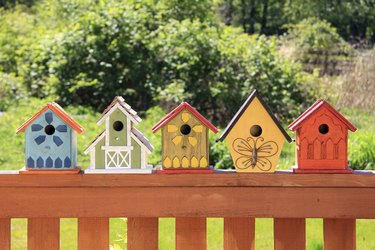
You may be a serious birder, a bird-watching beginner or someone who simply enjoys backyard tweets and twitters, but squirrels can ruin the experience -- for you and the feathered family that nests in your birdhouse or nest box. Squirrels, however, aren't necessarily your enemies; they're just in search of food and shelter, as are all little critters, but some squirrels see eggs and young birds as food. Instead of initiating war, discover ways for you all to live -- or nest -- peacefully.
Birdhouse Hangups
Video of the Day
Squirrels accustomed to birdseed at a feeder may check whether or not a birdhouse also contains birdseed. As with a hanging bird feeder, a birdhouse or nest box that hangs too close to the ground or anything climbable is no feat for a squirrel that can jump 8 feet to the side, 4 feet straight up and 15 feet down. Using these jump distances plus an extra 1 foot for good measure, hang your nest box far enough from the ground, trees and fences, out from its hanging pole or down from its branch to at least foil the furry Olympians' efforts.
Video of the Day
Pole Protection
You might think that by placing a birdhouse on a tall enough pole away from anything squirrels could jump from would keep these long-jumping critters at bay, but think again: They're expert climbers, too. They can climb only what they can get their claws into, however. If you wrap the pole with a disc baffle, sheet metal, an old chimney pipe, polyvinyl chloride pipe or any smooth, durable material, you'll thwart their climbing ability -- and maybe even enjoy the comical show, watching them slide down as they try and try again to access the little house above until they finally give up.
Hole Protection
The birdhouse's entrance hole should be just big enough for the type of bird you want to attract, such as 1 1/4 inch in diameter for a brown-headed pygmy and red-breasted nuthatch or 1 1/8 inch for a chickadee. Although a small hole keeps large birds out, squirrels simply chew away enough wood around the hole to squeeze through; 1 1/2 inches is all the space they need. By fitting the hole's edges with a metal hole guard or reducer, you have more control over what goes in the house and what doesn't.
Squirrel Visitation Rights or Restraining Orders
With a well-planned nest box and enough patience, you should be able to convince squirrels that they aren't welcome. If you resort to feeding them, do so far from the nest box to quell their need for sustenance and possibly halt their attempts at birdhouse "breaking and entering" in search of food or shelter, but understand the problems that come with such kindness. The University of Nebraska–Lincoln Extension explains that encouraging squirrels to visit a yard may lead to them nesting in the accompanying home, where they can destroy insulation and chew on electrical wires. The latter activity may cause a fire. If you plan to feed squirrels, then also supply them with den boxes to help discourage them from turning your home into theirs.
- National Wildlife Federation: Tired of Squirrels Raiding Your Bird Feeders? Here Are 10 Ways to Outwit Them
- University of Nebraska-Lincoln Extension: Control of Tree Squirrel Damage
- U.S. Fish and Wildlife Service: Homes for Birds
- Sialis: Hole Guards and Reducers
- Missouri Department of Conservation: Build a Squirrel Den